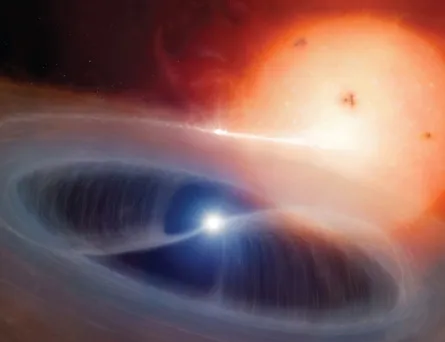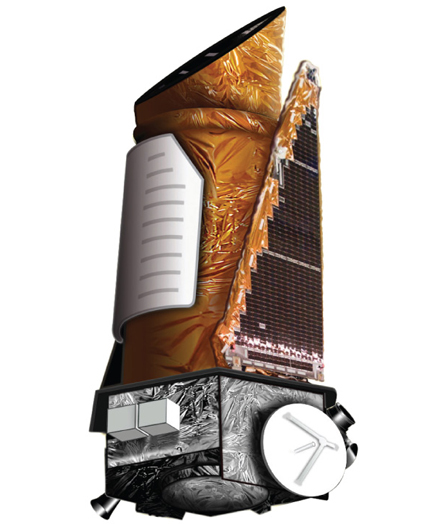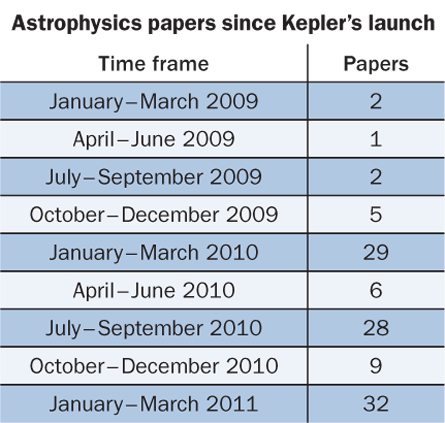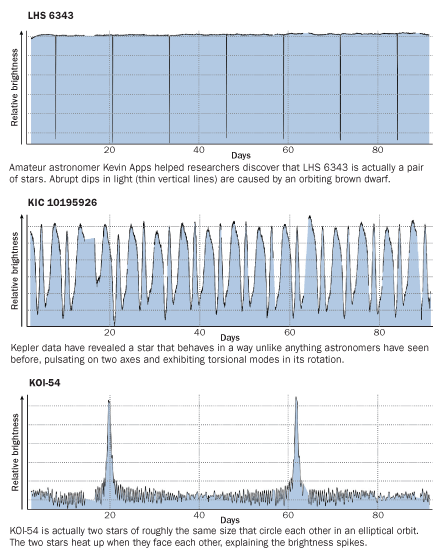- More than 2 years ago
After mind-bendingly precise data and artists’ renditions of mysterious stars played across the screen, Martin Still leaned into his lectern at an American Association for the Advancement of Science meeting early this year to deliver a plea to fellow astronomers. In one word: Help!




“We need you guys,” said the manager of NASA’s guest observer program for Kepler, among the most successful space telescopes ever launched. “Wait a year and it’s too late.”
Kepler has found a bonus, a treasury of wonders, or one might say a stellar freak show out in space. The result is a predicament: This is not what the space telescope was looking for. Kepler’s NASA team has one job that it must, by contract, pursue almost exclusively — hunting for extrasolar planets. In-house researchers must largely ignore other wonders. Hence the call for aid from guest observers, people given access to a telescope’s data, but who typically provide their own resources to analyze the results and pursue more.
In science, new instruments routinely discover unexpected things. But Kepler’s surprises — which could help astronomers learn far more about the evolution of stars, their internal structures and how the burning balls of plasma die — require fast action if they are to be fully examined.
The telescope honors 17th century German astronomer Johannes Kepler. He was first to realize that planets follow elliptical, not circular, orbits, and he established three laws of planetary motion. “Our mission is to find planets. We hope to find Earthlike planets,” says the project’s founder and principal investigator, William Borucki of NASA’s Ames Research Center in Mountain View, Calif. Borucki spent decades fighting against great skepticism to build an orbiting instrument so sensitive it would detect planets that briefly cross, or transit, their stars’ faces.
NASA launched the telescope in March 2009 into a “trailing” orbit. Sitting slightly farther from the sun than Earth does, Kepler makes one trip around the sun every 372 days, gradually falling farther behind Earth. In its solitude, the spacecraft keeps its eye on hordes of stars, checking for planets.
It is finding them, too, in scads. There are more than 1,200 entries on Kepler’s list of candidate planets (SN: 2/26/11, p. 18) betrayed by small, repetitive and distinctively shaped dips in the brightness of their parent stars — the shadow of a planet crossing a star’s face as seen by the craft. While further analysis surely will reveal some as false alarms, chances are that 90 percent are real. That will triple the number of known exoplanets. With time, scientists hope to confirm a few with Earthlike size, orbit and other conditions suitable for life as we know it to arise.
But the majority of stars don’t have planets lined up to block light headed toward Kepler. These stars too are worthy of study. Still, who is based at Ames, hopes outside astronomers will take a close look at Kepler’s new data on stars without signs of planets, plus look at those stars with other scientific instruments while the craft is still operational.
Eye for the weird
“There are so many stars that show bizarre, utterly unexplainable brightness variations that I don’t know where to begin,” says Geoff Marcy of the University of California, Berkeley. Marcy gained fame in the mid-1990s when he helped pioneer, with ground-based instruments, discovery of extrasolar planets; he joined the Kepler team to help expand the planet-finding toolbox. After the detection of far more than planets began overwhelming the Kepler program, Marcy hired an undergraduate statistics major to scan the plots of varying brightness for tens of thousands of stars. He trained her to spot what Marcy calls the WTF objects, which might politely be rendered “What The Flip is that?”
Astronomers have already spotted stars with remarkable pulsation modes, double stars orbiting so closely that streams of white-hot plasma flow between them, immense star spots whose movements hint at unlikely rotations, collapsed white dwarf stars in eclipsing orbits around large and seemingly younger stars, and more. “These phenomena have never been seen before, or never with such clarity. This is a gold mine,” Marcy says.
Ironically, the bounty comes from a telescope that Borucki has often called, tongue in cheek, the most boring space mission in history. All Kepler does is look, occasionally pausing to realign its solar panels, at one starry patch of sky about as big as a hand held at arm’s length. The target is roughly between the Northern Hemisphere constellations Cygnus and Lyra.
About 4 million stars in Kepler’s view are bright enough to study closely. Unlike most telescopes, its camera gathers no spectra that directly reveal chemical composition. The main objective is to measure star brightness, an astronomical procedure called photometry. Stellar photometry has never been done before on this scale or with this accuracy. With 42 CCD photo chips, or about 95 megapixels in all, Kepler’s camera — the largest ever put in orbit — can detect changes in brightness to well under 0.01 percent, good enough for Earth-sized planets orbiting sun-sized stars. There is capacity on the radio link to Earth for about 6 percent of the data avalanche. “We throw away the rest,” Still says. Thus choosing which stars’ data to hold onto is essential.
Most of Kepler’s attention is on 156,000 stars selected because they appeared from pre-Kepler data to be more or less sunlike, fairly stable in their output. Even among these stars, most light curves are not checked by human eye; computer programs recognize and flag those with the regular, slight dips suggestive of planets. Researchers can request up to 512 extra objects for detailed study: stars already excluded from planet study, perhaps, but interesting for other reasons, or background galaxies.
Already, general astrophysics papers (meaning papers about stars) published from the mission outnumber those dealing with planets. Some papers are on single stars that turned out to be double or triple systems, or stars orbited by — and sometimes consuming — whirling disks of gas, plasma and dust. Such things were already known to exist, but to have so many in such detail is new. Anybody can go to the Kepler website, pick at random one of the 156,000-plus or so stars on the target list, and command the Kepler server to plot and display the star’s light curve.
An amateur helps himself
Even amateurs are welcome to try. One such amateur is Kevin Apps, an engineer in Surrey, England. He works days managing natural gas pipeline flows but has published several astrophysics papers with professionals. Shortly after Kepler went into orbit, Apps looked in the telescope’s data file for a red dwarf about 120 light-years away that he knew about from star catalogs. To his surprise it had not been included in the list of 156,000 for Kepler’s close attention.
From his home computer Apps found that he could retrieve the light curve using data gathered during the telescope’s initial commissioning phase. The light curve had four dips spaced 12.71 days apart, suggestive of planet-sized transits. He contacted John A. Johnson, an assistant professor at Caltech whom Apps had worked with before.
Intrigued, Johnson recruited eight other professional astronomers. They obtained spectra with telescopes in California and Hawaii. Analysis revealed not, as the catalogs say, a single star but instead a wide-spaced pair, or binary, of red dwarfs (also known as M dwarfs, the most common kind of star in the galaxy). One is about 30 percent and the other 37 percent as massive as the sun. They circle one another every 100 years or so. With an adaptive optics system on the famed 200-inch telescope at Mount Palomar in California, the team even got a fuzzy photo showing two distinct stars.
And the dips in starlight? They are indeed caused by something about the size of a large planet in orbit about the larger of the two dim stars. But it is no planet. Orbital motion betrays a mass 63 times that of Jupiter, Johnson, Apps and colleagues reported April 1 in the Astrophysical Journal. That makes it a brown dwarf, or “failed star” in the fuzzy border between planet and star, lacking the internal temperature and pressure to drive hydrogen fusion. The body’s transits make it among the least massive for which an exact radius has been determined.
“I’m blown away by the scientific impact of the Kepler mission,” Johnson said via e-mail. “It’s not often that astronomers get order-of-magnitude gains in precision or sample size, but Kepler has provided both.… My students and I are like kids in a candy store!”
And passionate hobbyist Apps says, “For an amateur to be involved … and to be published, that is as good as it gets, really.” (Apps’ successes have led a filmmaker to plan a movie dramatization of his adventures.)
Ringing like bells
From the start, the Kepler mission recruited hundreds of specialists in the field of asteroseismology to help with the planet search. These scientists look at the flickers of stars to collect key data for deducing the size of an orbiting planet. But the scientists have been astonished at how much else they can tell about stars with Kepler’s data. Don Kurtz, an astronomer at the University of Central Lancashire in Preston, England, is coauthor of what he calls the first asteroseismology textbook, published in 2009. Its foreword declares that the pulsations in a star’s light due to sloshings of the star’s atmosphere are physically similar to low-frequency sound waves.
Thus modern asteroseismology echoes a theory first put forward by Pythagoras that heavenly spheres make divine music. The vibrations of stars offer details about their internal structures, like a symphony’s sound reveals the composition of the orchestra. The introduction to Kurtz’s textbook says that just as “you can ‘hear’ the shape of the instrument, we can use the frequencies, amplitudes and phases of the sound waves that we detect in the stars to ‘see’ their interiors — to see their internal ‘shapes.’ ”
Kurtz likened the technique to ultrasound exams that tell doctors the health and sex of a developing fetus. In fact, a team reported in the April 8 Science measurements from Kepler that reveal pulsations that echo all the way from the center of a star, a red giant.
“Until Kepler, I was doing the best stellar photometry in the business. The very best I could ever do, Kepler is doing it at least 10 or 20 times better, and most of the time it is 100 to 1,000 times better, while looking at 156,000 stars at once.”
Kurtz recently examined Kepler’s data on one star, known as KIC 10195926. It does something he has never seen: It quivers, or pulsates, on two axes of symmetry at once. The star is roughly twice the sun’s mass and has now been classed as an Ap star, for A-peculiar, with a strong magnetic field. A paper by Kurtz and collaborators published online in April in the Monthly Notices of the Royal Astronomical Society reported that the star exhibits “torsional modes” in its rotation. Nothing like that has been seen before, either. It means the star’s northern and southern halves trade off, one spinning faster than the other and then vice versa — a little bit like a dancer turning and doing the twist at the same time, shoulders and hips moving in opposite sync.
As such discoveries pile up, competition for time on ground-based telescopes in the Northern Hemisphere is already spiking for late summer, the peak of “Kepler Season” when the satellite’s target is high in the Earth’s night sky. Astronomers want to gather more information on objects that Kepler’s data reveal to be interesting, or to make a case for objects that Kepler’s handlers should add to their list.
A furious tango
Many of the stars Kepler is looking at have been visible in telescopes for centuries but, like most nondescript-looking stars, got little notice. What standard star catalogs say about seldom-examined stars is often sketchy or wrong. An example is HD 187091, about 1,000 light-years away. The Henry Draper Catalog of 1918–24 lists it as an ordinary A-class star, a type about twice as large and as massive as the sun. It did not seem unusual in any way.
But within just 10 days of operation, Kepler returned an astonishing light curve. Every 42 days the star’s brightness rose to a sharp peak and quickly fell, regular as a metronome. The rise was less than 1 percent, “but to Kepler, that is huge,” says William Welsh, an astronomy professor at San Diego State University. Furthermore, a complex forest of secondary brightness variations continued at a lower level in between the dramatic brightness peaks.
One hypothesis was that the star is orbited by a black hole, its strong gravity lensing the star’s light into a beam that briefly aims at Earth once every orbit. A platoon of astronomers got time on NASA’s Swift telescope to seek signs of a black hole’s telltale X-rays, but no luck there. A spectroscopic examination with half a dozen ground-based telescopes solved the puzzle.
HD 187091, now known as KOI-54 for “Kepler Object of Interest No. 54,” is not one A-star but two of nearly the same size, one 2.19 and the other 2.33 times the sun’s 1.39-million-kilometer diameter. They are in a wildly stretched-out, elliptical orbit. Every 41 day, 19 hour orbit sends them racing nearly toward each other and zipping around one another at a separation equal to only about three times each one’s diameter, and then flings them almost 120 million kilometers apart.
The brightening occurs as the stars, tidally warped by their gravity at closest approach into slight egg shapes, roast one another on their facing sides and heat up. And that explains the spike in brightness, the team reported online in February at arXiv.org. The more surprising revelation of Kepler’s data is that one, and perhaps both, pulsate furiously at rates that are precise multiples of their rate of close encounters, in some cases pulsing exactly 90 and 91 times for each orbit. “Nobody had ever seen, or even thought, something like this could happen,” Welsh says. Discovering that a star’s rapid pulsations are not always driven by internal processes, but can be paced by a tidal metronome from a partner star, offers a new window into stellar dynamics and structure.
Stay tuned
In the next year or two, and longer if the Kepler mission is extended, myriad more discoveries like these are likely. Eventually the craft will go out of commission; at the outside it could keep working for an additional four or five years beyond its original mission end date of 2013, says deputy Kepler project scientist Steve Howell, also at Ames.
But the telescope’s abilities may be surpassed by another in the works. The European Space Agency is considering a mission called Plato, for Planetary Transits and Oscillations of stars. It could go up sometime between 2015 and 2025 with a prime mission much like Kepler’s — to study stars with planetary systems. The craft is to be parked in a libration point, a sort of kink in the sun’s and Earth’s combined gravity that will hold it hovering near Earth but far enough away to be able to stare constantly for long periods at one region.
But unlike Kepler, Plato will be able to swivel around and look at different parts of the sky, and will use bundles of telescopes to stare at larger pieces with even greater precision. Undoubtedly it, too, will find yet more stars whose wonders have nothing to do with planets. Who knows: It may even be able to check on some that Kepler found first, just to see how they’re doing.







